Rochefoucauld Family and Mention of Oak Island Novia Scotia
The Curse of Oak Island- Flavour 5, Episode 10: The Signs of a Cross
The following is a Plot Summary and Assay of Season 5, Episode 10 of the History Channel'southward TV serial The Curse of Oak Island.
.
.
[SPOILER ALERT!!!]
.
.
Plot Summary
At the Money Pit surface area, Rick and Marty Lagina and Charles Barkhouse stand up by every bit Irving Equipment Ltd. slowly sinks the H8 shaft. Rick is unsurprised when the hammergrab repeatedly emerges from the caisson bearing load upon load of old timbers, maxim, "information technology's almost certainly the Chappell Shaft." The narrator follows up on that argument past reminding us of Doug Crowell'due south discovery, presented in Season five, Episode v, that the Chappell Shaft was not constructed in perfect vertical alignment, its bottom lying 10-12 feet due north of its top. Perhaps, the narrator suggest, H8 will intersect the elusive Chappell Vault, which the Chappell Shaft patently bypassed.
Later, the Oak Island squad meets in the War Room with Doug Crowell. Crowell informs the team that he has discovered eight pages constituting what appears to be a ship'south log in the Nova Scotia Archives in Halifax. "What's actually interesting," says Crowell, "is it appears to be a ship's log that indicates that [the transport's crew was] hither in advance of the French armada that was coming over in 1746 to take back Acadia." The narrator then gives u.s.a. a history lesson on the failed Duc d'Anville Expedition of 1746, during which "the French launched an armada of 97 ships and 13,000 men… in an attempt to seize Nova Scotia and parts of the northern American colonies from the British," only to be thwarted by typhus, scurvy, and trigger-happy Atlantic storms. Crowell and so discloses that leader of this trek, the Duc d'Anville, was named Jean-Baptiste Louis Frederic de La Rochefoucauld, and was a fellow member of the La Rochefoucauld family introduced in Season 5, Episode viii.

Crowell then reads the following passage in the log:
"September half dozen
"Enter a deep bay. Southwesterly of Chebucto Bay [the original French name for Halifax Harbour, located 59 km (37 miles) northeast of Oak Island, as the crow flies]. Nonetheless no word of D'Anville, and the weather existence clear, we ready canvas, turning southwesterly along the coast, passing many rocky islands. At midday, we reached a deep bay with several hundred small islands, wooded to the shore. The current of air dying down, we anchored for the nighttime. The dandy quantity of treasure on this vessel makes it unwise to jeopardize it in any engagement with the enemy.
"September viii
"It has been agreed that a deep pit be dug and treasure securely buried. The pit do take a surreptitious entrance by a tunnel from the shore.
"September 13
"Down 67 feet. Pit seems clammy from seepage of seawater. Have decided to go deeper to dry soil."
"In my mind," concludes Crowell, subsequently he has finished reading, "there's no doubtfulness that they're pointing right to Oak Isle." Marty Lagina, nonetheless, expresses his concern that the narrative'south obvious parallel with the Oak Island mystery is about too perfect. Heedless of Marty's concern, Crowell further suggests that perhaps Zena Halpern's map, addressed to "Francois de La Rochefoucauld," was drawn upward past a member of the the Duc d'Anville Expedition who learned of the events described in the ship's log and decided to send discussion to a fellow member of the Duc's family; Jean-Baptiste de La Rochefoucauld, Duc d'Anville, died of typhus on George's Isle in Chebucto Bay on September sixteen, 1746, along with many of his men.
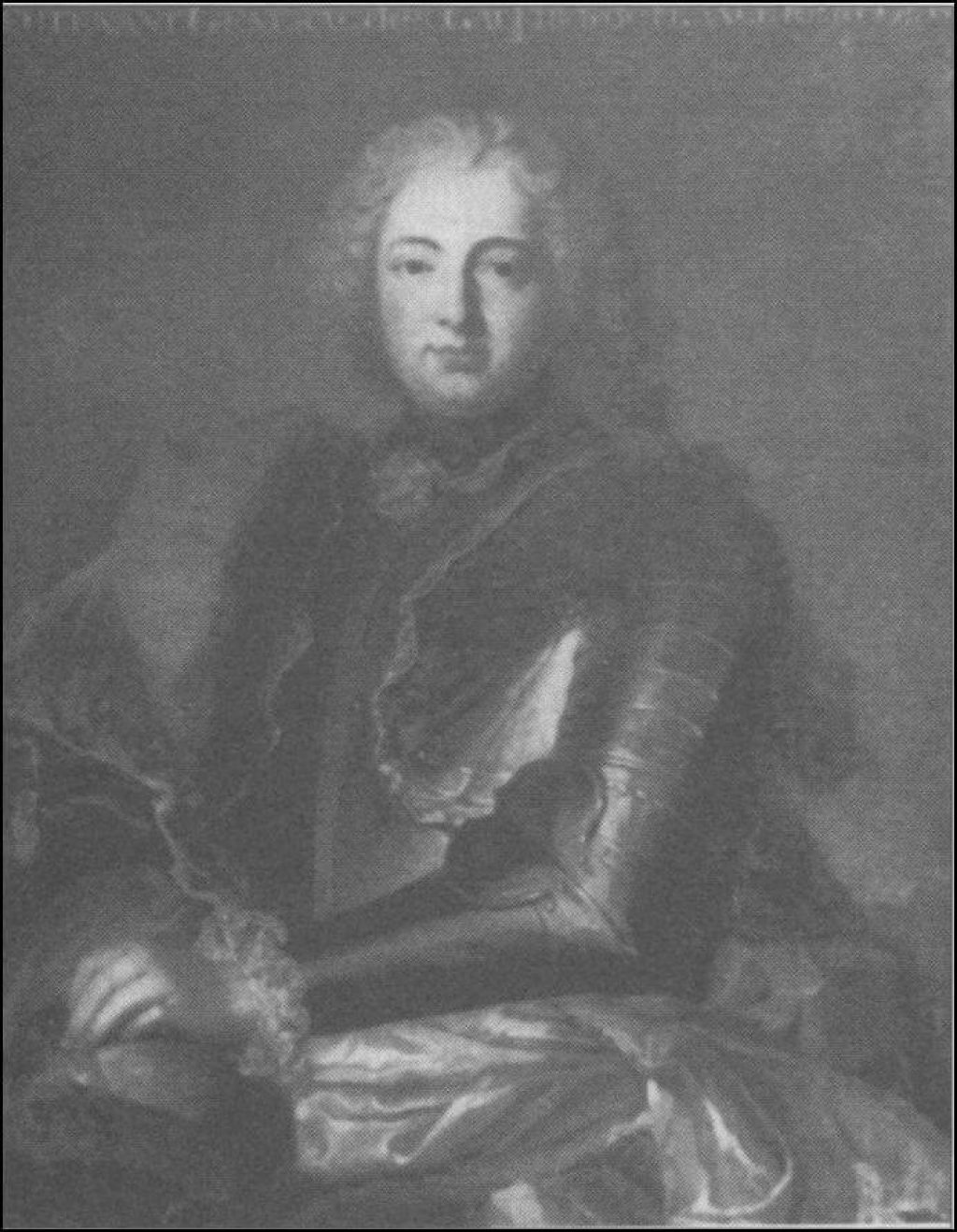
After, at the Money Pit area, Vanessa Lucido of ROC equipment informs Rick Lagina that the H8 shaft has been cased to a depth of 155 anxiety and excavated to a depth of 150 feet. Rick reminds Lucido that the anomaly they promise to investigate, beginning discovered in Flavour five, Episode 6, is located at a depth of around 160 feet. He cautions her that the next x feet ought to be excavated with farthermost intendance.
As the excavation proceeds, the narrator informs u.s. that the subsequent spoils brought up from H8 will be scanned with a metallic detector earlier being carefully sifted through past hand at a wash table. In the start batch of spoils, Gary Drayton discovers a pocket-sized metal spike. Presently thereafter, he recovers a much larger wrought-iron spike coated with what Marty Lagina suggests might exist concrete, evoking the description of the core sample retrieved from the Chappell Vault. When these same spoils are afterward sifted through at a wash table, Jack Begley discovers a fragment of what is almost certainly bone, evocative the human bone shards brought up from H8's 160-165-foot depths in Season five, Episode 5.
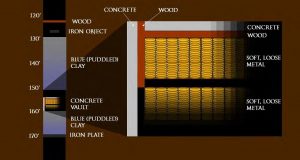 Suddenly, Vanessa Lucido informs the crew that the caisson has encountered a hard object at the 170-foot depth, and is nigh certainly "sitting on something" of significance. "It don't feel like metal," says oscillator operator Danny Smith. "It feels like I'thou on a whole bunch of wood at in one case at present." The narrator suggests that this potential mass of wood below the caisson might be the fabled Chappell Vault.
Suddenly, Vanessa Lucido informs the crew that the caisson has encountered a hard object at the 170-foot depth, and is nigh certainly "sitting on something" of significance. "It don't feel like metal," says oscillator operator Danny Smith. "It feels like I'thou on a whole bunch of wood at in one case at present." The narrator suggests that this potential mass of wood below the caisson might be the fabled Chappell Vault.
Rick and Marty discuss how best to proceed, both of them desirous of maintaining the integrity of whatsoever lies beneath the caisson. Unfortunately, there is very little caisson left to grind into the globe, as Oak Island Tours Inc. had ordered their custom caisson with the intention of sinking a 170-foot shaft. To brand matters worse, a thoroughly begrimed Jack Begley informs the crew that he used up all of the h2o reserved for washing the H8 spoils. With that, the crew decides to call it a day and meet in the War Room. In that location, later that nighttime, the crew decides to install a permanent inner casing inside the H8 shaft and continue earthworks with a smaller hammergrab.
The following 24-hour interval, while a permanent inner casing is beingness installed inside the H8 shaft, Rick Lagina and Gary Drayton become metal detecting on a detail stretch of Smith'southward Cove. After finding a bottle cap, the treasure hunters unearth a small-scale atomic number 82 cross with a large chain pigsty on the peak, which a very excited Drayton suspects was crafted anywhere from 1200-1600 A.D. Rick suggests that the cantankerous, with its large chain pigsty, closely resembles the shape of one of the crucifixes carved into the walls of Domme prison by members of the Knights Templar, which he and his nephews Alex Lagina and Peter Fornetti visited the previous episode. Gary encourages Rick to have the artifact examined by an expert as the latter phones upwardly Marty Lagina and Craig Tester to inform them of the find.
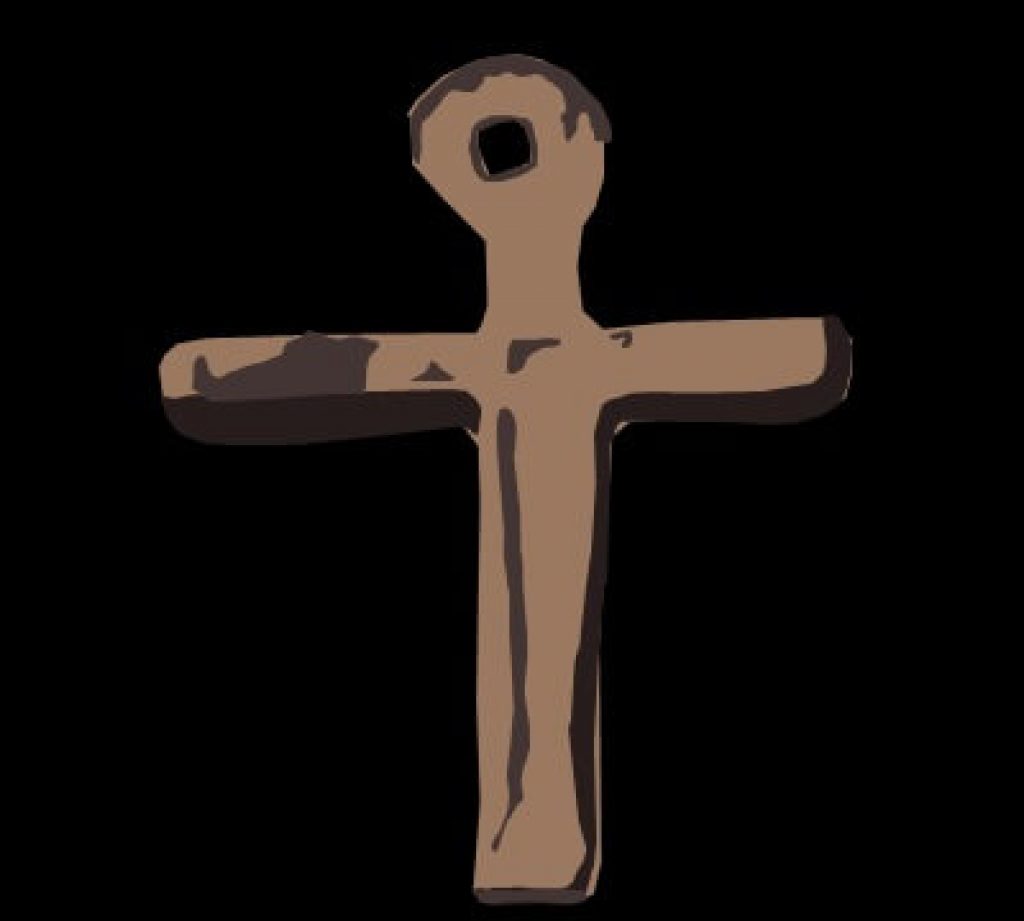
Analysis
The Send'due south Log
In this episode, Oak Island researcher Doug Crowell presents an eight-page document he unearthed in the Nova Scotia Archives in Halifax. This document is supposed to be the log of an 18th Century French treasure ship which constituted the vanguard of the Duc d'Anville Expedition, a 1746 French assault on British holdings in Acadia and New England which never came to fruition. The author of the log describes sailing southwest down the Acadian coast from Chebucto Bay (a.chiliad.a. Halifax Harbour) to what was either Mahone Bay or St. Margarets Bay (St. Margarets Bay lies immediately northeast of Mahone Bay on the other side of the Aspotogan Peninsula) when the Duc d'Anville's fleet failed to arrive on schedule. On one of the islands in this bay, the ship's crew purportedly dug a deep pit in which it hoped to coffin the treasure with which it was entrusted, as well as a "secret entrance" to the pit "by a tunnel from the shore"- structures strongly evocative of Oak Island'due south Coin Pit and the Smith'southward Cove alluvion tunnel, respectively. The log's terminal entry, dated September thirteen [1746], indicates that the coiffure members dug their pit to a depth of 67 feet that day, whereupon they encountered seawater. Although the author states the crew's bizarre intention to go on excavation in an endeavor to reach "dry out soil" further below, there are no further entries in the log. We are left to speculate as to the cause for this abrupt ending.
If these 8 pages truly constitute the log of an 18th century French ship, and if the events recorded in the log truly took place, it is likely that Doug Crowell has solved much of the Oak Island mystery; the chance that at that place is more than than one island in or very almost to Mahone Bay on which a deep treasure pit and an adjoining hidden seaward tunnel was secretly constructed seems slim. However, there is at to the lowest degree one detail which casts some doubt on the authenticity of the certificate in question. In the show, while Crowell reads from a transcript of the ship's log, we are shown images of handwriting which represent with Crowell'southward narration, ostensibly taken from a photocopy of the original manuscript. This handwriting, similar Crowell's narration, is in English language. If Crowell'southward document truly constitutes the log of an 18th century French ship as purported, yet, information technology would almost certainly have been written in French. Fortunately, Crowell addresses this potential problem on social media in spite of his non-disclosure understanding with the producers of The Curse of Oak Island, which precludes him from prematurely revealing some of his inquiry discoveries with the general public. In a Facebook post, Crowell indicated that the eight pages he presented in this episode constitute a handwritten English translation of the original French log, which a certain Oak Isle researcher donated to the Nova Scotia archives in 1968. In accordance with his NDA agreement, Crowell refrained from commenting on the original French log and the identity of the researcher who supposedly discovered it.
The Duc d'Anville Expedition
The same transport's log presented past Doug Crowell in this episode was allegedly written by a member of the 1746 Duc d'Anville Expedition, a French armed forces operation conducted in King George's War, the Northward American theatre of the War of Austrian Succession.
From a N American perspective, King George'southward War was but one of six military conflicts fought between the British and French and their Beginning Nation allies in their corresponding New Globe colonies, New England and New France. These wars, dubbed the "French and Indian Wars," were all sub-conflicts of much larger pan-European wars fought on the European continent.


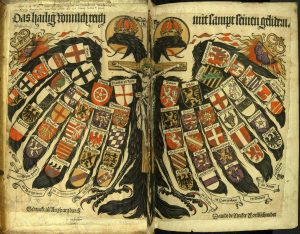
In order to empathise King George's War and the larger disharmonize of which it was a part, the State of war of Austrian Succession, we must know a little about the Holy Roman Empire. The Holy Roman Empire (800-1806) was an agglomeration of Germanic kingdoms revolving around what is at present Federal republic of germany, which also included nowadays-day northern Italy, eastern France, Austria, Switzerland, Czechia, western Poland, and sometimes parts of the netherlands. Founded in the early on 9th Century A.D. (according to some historians) by the Dark Age Frankish warlord Charlemagne, it purported to be the successor of the in one case-mighty (Western) Roman Empire. In truth, however, it was, equally French Enlightenment author Voltaire is said to have quipped, "neither holy, nor Roman, nor an empire," every bit it'due south relationship with the Vatican was often rocky, it was essentially High german, and it was more of a loose confederation of kingdoms than a centrally-organized empire.
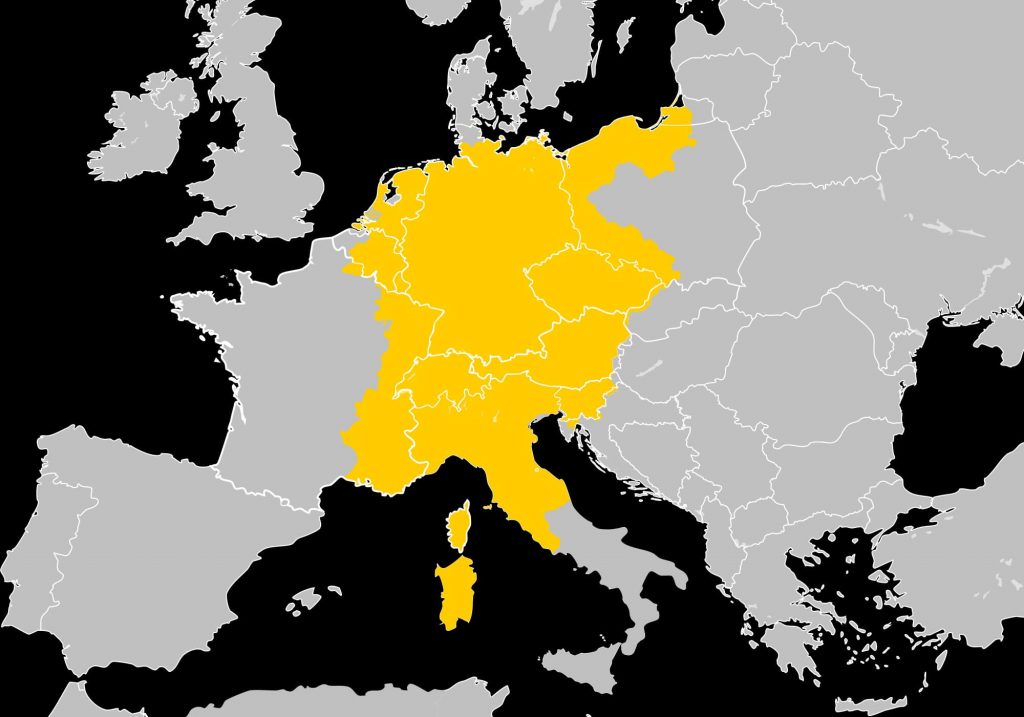
In 1438, a member of an Austrian family unit known as the Firm of Habsburg was elected Holy Roman Emperor. The Habsburgs would concord this position for the side by side three centuries, retaining and expanding their influence through strategic, often inter-familial marriages. Ironically, these inter-House marriages which initially brought the Habsburgs then much success would eventually testify to exist their undoing.
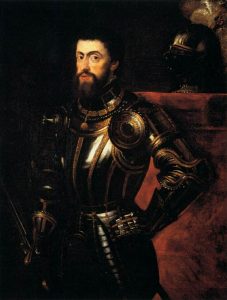
In the late 1400's, Philip the Off-white of the House of Habsburg married Juana de Castille, heiress to the immature and flourishing kingdom of Kingdom of spain. In the late 1510's, Philip and Juana'due south son Charles succeeded his paternal grandfather as Holy Roman Emperor (becoming Charles V), and his maternal grandparents as King of Spain (becoming Carlos I). In this way, the House of Hapsburg gained control of both the Castilian and Holy Roman Empires. Although this mega-empire separated when Charles was succeeded in Spain by his son, Philip II, and in the Holy Roman Empire past his younger brother, Ferdinand I, Spain (under the rule of the Spanish branch of the Habsburg family) and the Holy Roman Empire (nether the rule of the Viennese branch of the Habsburg family) remained shut allies for the residuum of their existences.
Every bit mentioned, the Habsburgs consistently intermarried with each other in order to keep power within the family. Over time, this remote inbreeding had an
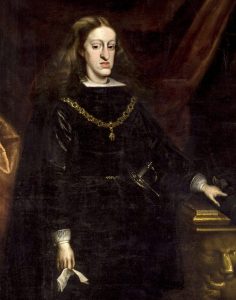
increasingly deleterious effect on the genetic wellness of the family, and within a few generations, the Firm of Habsburg was plagued by genetic disorders. By the late 1600'southward, it became clear that the severely-inbred Charles Ii of Spain, known as "the Bewitched" for his concrete and mental disabilities, was incapable of producing an heir, and would be the concluding of the Castilian Habsburgs to rule Spain.
Following the death of Charles 2 in 1700, diverse European powers fought to put their preferred candidates on the vacant Spanish throne. In this conflict, known equally the War of Spanish Succession, France and its allies fought to crown Philip of the French House of Bourbon (the grandson of the French "Sun" Rex Louis Xiv) King Philip V of Spain, while the Holy Roman Empire and its allies supported the merits of Charles, Archduke of Republic of austria, a relative of the late King Charles II of Spain who would 1 solar day become Charles VI, Holy Roman Emperor. French republic ultimately won this war, and Spain was ruled by French Bourbon monarchs for the next century and a one-half.
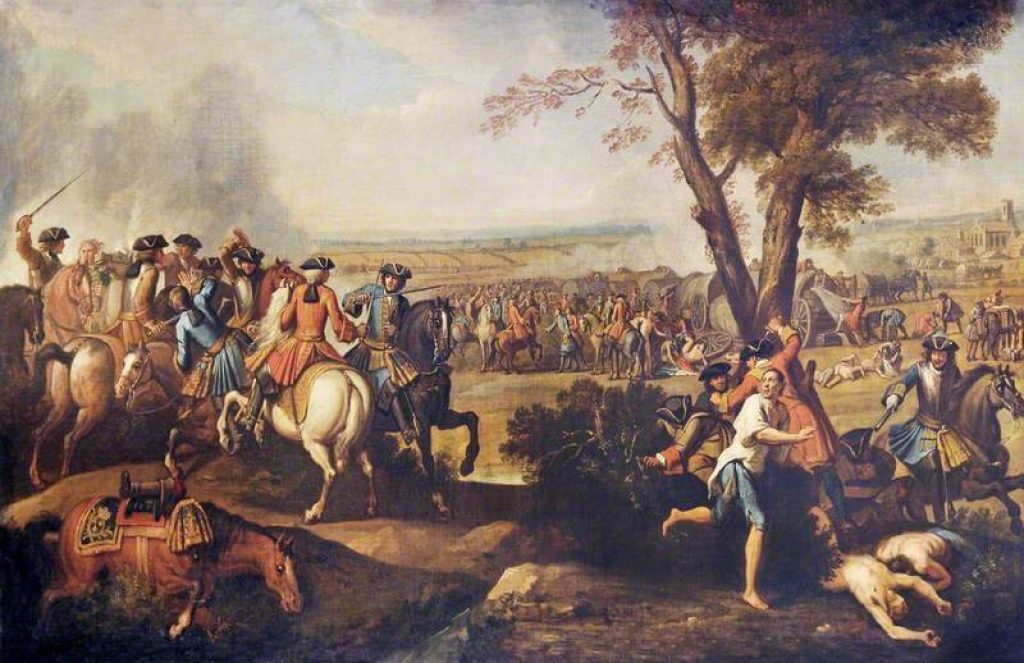
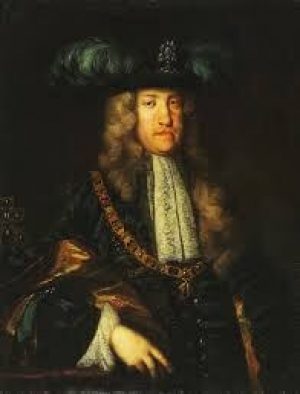
In 1740, the losing candidate of the State of war of Castilian Succession and the final of the Viennese Habsburg line, Holy Roman Emperor Charles Half-dozen, died after eating poisonous mushrooms on a hunting trip. Like Charles Ii'southward expiry in Spain, Charles VI'south decease in the Holy Roman Empire spurred a state of war of succession. At the time of his expiry,

Charles VI was survived by several daughters who, according to Salic police (an ancient Frankish code to which many Germanic states adhered), were unable to inherit his throne. The remaining Habsburg family and their allies disregarded this ancient statute and supported the merits of Charles' eldest daughter Maria Theresa (the future mother of Marie Antoinette). France, Bourbon Kingdom of spain, and their allies, on the other mitt, contested Maria Theresa's claim.
It must be mentioned that, by this time, the Holy Roman Empire was a mere shell of its erstwhile self, having fractured into independent Cosmic and Protestant kingdoms in the backwash of the xxx Years' War, a devastating religious-turned-political pan-European state of war fought between pro and anti Habsburg nations from 1618-1648. Although Charles VI, at the time of his death, was nominally the "Holy Roman Emperor," he actually merely controlled a handful of kingdoms referred to collectively every bit "Austria". For this reason, the war that followed Charles Six's death was chosen the War of Austrian Succession.
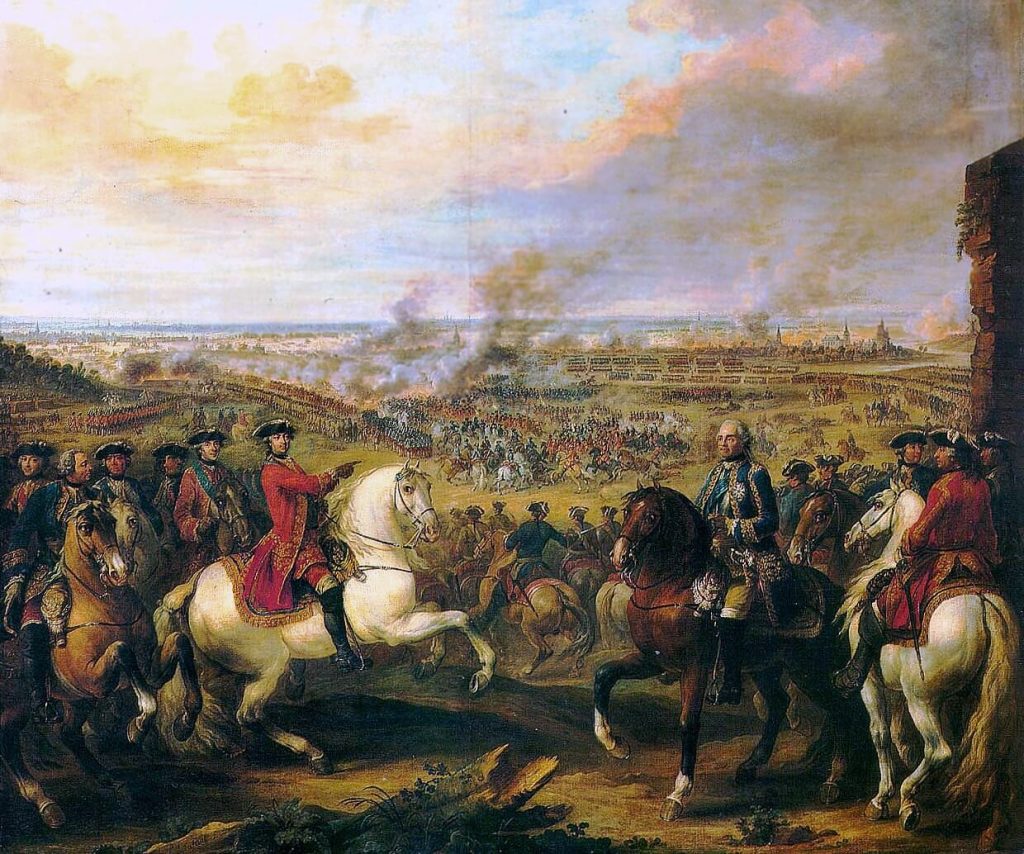
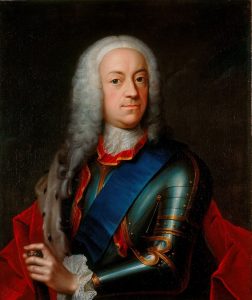 Ane of Maria Theresa's supporters during this conflict was King George II of United kingdom, who is mentioned in connection with Oak Island in Season 4, Episode viii and the Season four Finale of The Curse of Oak Isle. George II'south father, George I, was the showtime "Hanoverian" male monarch of Bang-up United kingdom of great britain and northern ireland. For virtually of his life, he served equally the leader of Hanover, a Protestant German land which was one time a office of the Holy Roman Empire and a long-time ally of the Habsburg family. In 1714, however, post-obit the death of the childless Queen Anne of Uk, British Parliament invited him to rule equally male monarch of U.k., equally they were desperate to keep a Protestant on the throne (as opposed to a Catholic). George readily accepted the offering, and was crowned Rex George I of Great Great britain. When the State of war of Austrian Succession erupted, his son and successor, King George II, decided to support the claim of Maria Theresa due to the long-fourth dimension alliance betwixt Hanover, his ancestral home, and the Habsburg family. In 1743, George led a joint British-Hanoverian army against French forces at the Battle of Dettingen, becoming the last British monarch to pb his troops in battle. The following twelvemonth, France formally declared state of war on Swell Britain.
Ane of Maria Theresa's supporters during this conflict was King George II of United kingdom, who is mentioned in connection with Oak Island in Season 4, Episode viii and the Season four Finale of The Curse of Oak Isle. George II'south father, George I, was the showtime "Hanoverian" male monarch of Bang-up United kingdom of great britain and northern ireland. For virtually of his life, he served equally the leader of Hanover, a Protestant German land which was one time a office of the Holy Roman Empire and a long-time ally of the Habsburg family. In 1714, however, post-obit the death of the childless Queen Anne of Uk, British Parliament invited him to rule equally male monarch of U.k., equally they were desperate to keep a Protestant on the throne (as opposed to a Catholic). George readily accepted the offering, and was crowned Rex George I of Great Great britain. When the State of war of Austrian Succession erupted, his son and successor, King George II, decided to support the claim of Maria Theresa due to the long-fourth dimension alliance betwixt Hanover, his ancestral home, and the Habsburg family. In 1743, George led a joint British-Hanoverian army against French forces at the Battle of Dettingen, becoming the last British monarch to pb his troops in battle. The following twelvemonth, France formally declared state of war on Swell Britain.
One time war was officially alleged, colonists in New French republic attempted to retake peninsular Nova Scotia, which France had lost to the British during Queen Anne's State of war (the North American theatre of the State of war of Spanish Succession). First, French soldiers stationed at the formidable Fortress of Louisbourg (located on the eastern shore of Cape Breton Island, Nova Scotia), accompanied by their Wabanaki Start Nations allies, attacked and utterly destroyed the British outpost of Fort William Augustus (located on the northeastern tip of mainland Nova Scotia), in doing and so touching off what is known equally King George's War, the North American theatre of the War of Austrian Succession. Presently thereafter, a militant French missionary named Jean-Louis Le Loutre led a force of Acadian colonists and a huge war party of Mi'kmaq warriors in a failed attack on Annapolis Majestic, a French-turned-British settlement founded in the early on 1600'south by Pierre Du Gua de Monts and Samuel de Champlain and taken by the British during Queen Anne's State of war. Ii months afterwards, French forces besieged Annapolis Royal a second time, only to retreat with the arrival of a ruthless state of war party of Wampanoag and Nauset braves loyal to New England.
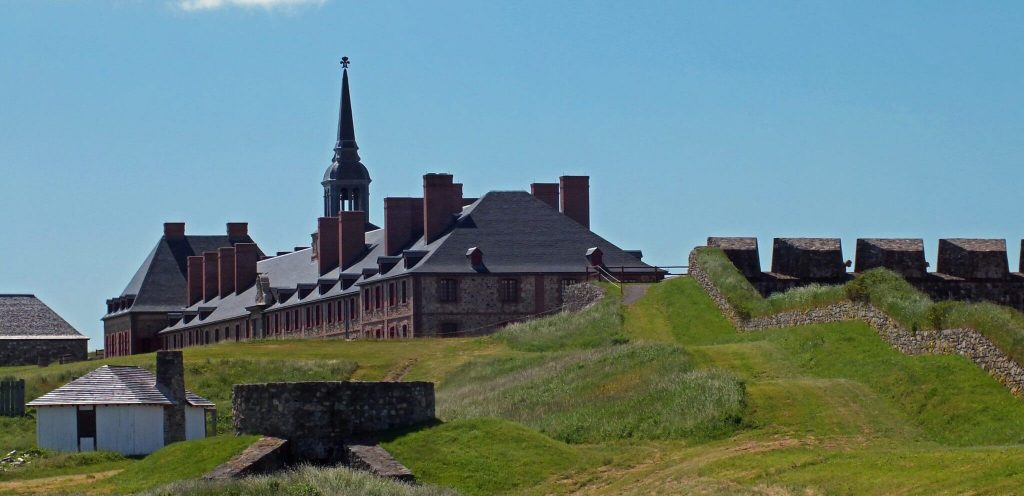
In 1745, the British retaliated by launching an assault on the Fortress of Louisbourg. Afterward a grueling month-and-a-half-long siege during which 900 redcoats died of disease, the beleaguered French defenders surrendered the fortress to the British.
While their Wabanaki allies took their revenge on the British by raiding New English language settlements along the coast of present-24-hour interval Maine, the French planned a massive expedition to recapture Louisbourg and Annapolis Royal, ravage New England, and raze Boston to the ground. This enterprise, headed by Admiral Jean-Baptiste Louis Frederic de La Rochefoucauld, the Duc d'Anville, is known as the Duc D'Anville Expedition.

On June 22, 1746, the Duc D'Anville set out from France with 73 ships, 800 cannons, and thirteen,000 soldiers- the largest military force ever to fix sheet for the New Globe. On its style across the Atlantic, the French fleet was beset by a series of terrible storms, during which several ships were struck by lightning. To brand matters worse, epidemics of typhus and scurvy rippled through the troops. By the fourth dimension the ragged remains of d'Anville'due south once-formidable fleet limped into Chebucto Bay, Nova Scotia (present-24-hour interval Halifax Harbour) on September 10, 1746, nearly 2,500 Frenchmen were dead. Only half-dozen days after his arrival, D'Anville himself died quite of a sudden and mysteriously. Although D'Anville'southward dr. believed the admiral died of a stroke, some historians believe that he succumbed to disease, while others suspect that he took his own life.
Afterward recovering and taking on fresh supplies in the Bedford Basin, the survivors of the French fleet made a feeble endeavor at attacking Annapolis Majestic. Again, they were thwarted past violent Atlantic storms, and at last decided to render habitation to France, utterly defeated by the elements.
The Identity of the Send
In light of the transport's log presented in this episode, one of the most interesting elements of the Duc d'Anville trek is the inflow of 2 French scouting ships in Chebucto Bay several months in advance of the main fleet. These vessels include l'Aurore, which left France on April ix, 1746, and le Brush, which departed several weeks after. Both ships had arrived in Chebucto Bay by June, whereupon they patrolled the coastline for quondam earlier heading back to French republic on Baronial 12 (a full calendar month before the final entry in the transport'south log presented in this episode), when the Duc D'Anville's fleet failed to arrive on schedule. Both vessels arrived in France on September 22.
Behind schedule, the Duc d'Anville, upon budgeted the Acadian declension, tasked the crew of one of his frigates, chosen Renommee, with sailing ahead of the main armada to intercept fifty'Aurore and le Castor ; the admiral correctly suspected that the ii scouting ships would depart for France when he failed to arrive on fourth dimension. En road to Chebucto Bay, the Renommee encountered and was subsequently hounded by an English vessel, and only managed to arrive at Chebucto after D'Anville'due south fleet. This puts the Renommee in the waters off the Acadian coast in the time frame indicated by the aforementioned ship'due south log. Is information technology possible that the eight pages presented past Doug Crowell in this episode come from the log of theRenommee?
I potential problem with this proposition is the fact that in that location are no indications that the Renommee was conveying any sort of treasure during the Duc d'Anville Trek, dissimilar the ship who's log Crowell presented in this episode. At that place were, all the same, several other French vessels associated with the Expedition which were definitely laden with treasure. In the summer of 1746, in accord with an earlier arrangement, an aloof French naval officeholder named Hubert de Brienne, Chevalier de Conflans, fix out for Chebucto Bay from the Caribbean with four warships:le Terrible, le Neptune, Valcyon, and la Gloire. Later exchanging cannon fire with a squadron of English men-of-war off the declension of Hispaniola and incurring pregnant damage to his ships, the Chevalier de Conflans dutifully made his mode to the Acadian coast. Upon his arrival, withal, he could find neither Chebucto Bay nor whatever trace of d'Anville'due south fleet; unbeknownst to him, d'Anville's fleet was still inbound, and had even so to arrive. Several days earlier d'Anville's arrival on September 10, 1746, Conflans decided to render to France. The date of his difference is eerily similar to that of Crowell's mystery ship, which left Chebucto Bay for what is presumably Oak Island on September half-dozen, 1746.
On their way habitation, Conflans and his crew captured an English language transport called the Convener, from which they appropriated an estimated 100, 000 livres-worth of treasure. In this way, at least ane ship associated with the Duc d'Anville Expedition is known to have carried treasure in its hold. Where the Ronommee fails to accord with Crowell'south mystery ship due to its lack of treasure, withal, Conflans' ships similarly fail to accord on account of the fact that they acquired their treasure after their deviation from the Acadian coast. In spite of this, no ships of which this author is aware correspond more closely with Doug Crowell'south mystery ship than the Chevalier de Conflans' men-of-war.
Desire to Aid?
If yous enjoyed this commodity and would like to help support this website, please check out our online bookshop:

LEGENDS OF THE NAHANNI VALLEY

THE OAK Isle ENCYCLOPEDIA

MYSTERIES OF CANADA: VOLUME I

Mysteries of Canada: Volume Ii

INDIAN TALES OF THE CANADIAN PRAIRIES

Archetype French-Canadian Folktales: Volume I

Two Journals of Robert Campbell
Source: https://mysteriesofcanada.com/nova-scotia/the-curse-of-oak-island-season-5-episode-10-the-signs-of-a-cross/
0 Response to "Rochefoucauld Family and Mention of Oak Island Novia Scotia"
Post a Comment